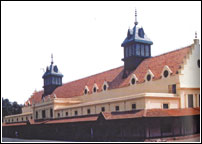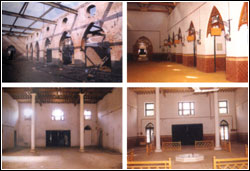If these walls could talk
By Samina Shah
Date:30-04-06
Source: Dawn
 IN living memory, the building often referred as “Tollington”, has been a provision market. In fact it has been the main market for a long time for household products, and since it stands close to the Punjab University, the National College of Arts (NCA), and a host of other educational institutions, generations of students remember it with nostalgia.
IN living memory, the building often referred as “Tollington”, has been a provision market. In fact it has been the main market for a long time for household products, and since it stands close to the Punjab University, the National College of Arts (NCA), and a host of other educational institutions, generations of students remember it with nostalgia.
This edifice stands at the intersection of two axes, and the north to south alignment is from the old city of Lahore and the British cantonment, and the east to west is the old and new Anarkali bazar. Seen in the context of the colonial British policy for arts and industry, in 1864 the Tollington building was erected to house an exhibition of Indian crafts — an event that was immensely popular and continued for a period of nine months.
Looking at the chain of events as a sequel to this, the building housed antiquities and by the end of the 19th century it became the birth place of the Lahore Museum and later the NCA.
Meanwhile, during the First World War, Tollington fell into neglect. A few years later it found its fortunes turning when at the end of the war the British administration began to attend to civilian matters. Giving Tollington a new look in 1922, Sir Ganga Ram was given the charge for its restoration and repair work, and it was then that a flat one replaced the slanting wooden roof.
 However, for the curious student of architecture (and the general public), one interior wall of the present building has been deliberately left bare, that is, kept without plaster, to facilitate the observation of different stages of masonry and structure. The size of the brick varies as the walls go up, since in those days there was no concept of protection against dampness. But recently the restorers of this building have carefully made the entire walls damp-proof by working at the base of an already built-up formation.
However, for the curious student of architecture (and the general public), one interior wall of the present building has been deliberately left bare, that is, kept without plaster, to facilitate the observation of different stages of masonry and structure. The size of the brick varies as the walls go up, since in those days there was no concept of protection against dampness. But recently the restorers of this building have carefully made the entire walls damp-proof by working at the base of an already built-up formation.
The building is in three sections: the main entrance hall, that is the waiting area, has benches of the same period and a fountain in the centre. The commercial building area, which used to have the fruit and vegetable market, has rows of open quarters as “one shop one craft” on both sides. Each room has a metal spiral staircase that goes up on the first floor of the same room as a loft for storage or book-keeping. The metal work is 19th century customised; the display boards outside each “shop” are ready as nameplates, described aptly in the novels of Somerset Maugham.
 Proceeding with the renovation and restoration, Sajjad Kausar, the architect who has spared no pains in bringing this building to completion, says: “If the re-use of the building is close to the original, then the intervention is minimum, as making it better-looking or demolishing it is not restoration. In the building today, 1864 and 1922 have been cleverly combined.”
Proceeding with the renovation and restoration, Sajjad Kausar, the architect who has spared no pains in bringing this building to completion, says: “If the re-use of the building is close to the original, then the intervention is minimum, as making it better-looking or demolishing it is not restoration. In the building today, 1864 and 1922 have been cleverly combined.”
He is overly protective of his work, and so are his colleagues and advisors architects Nayyar Ali Dada and Kamil Khan Mumtaz — among others, who have closely followed its progress. “There is no place in Lahore for showcasing local crafts like the Covent gardens displays of the English crafts or the New Delhi State Emporium, which is a huge establishment for Indian crafts. The state ensures a price control, thus enabling the craftsmen to sell their products and attract tourists at the same time. I have restored this structure keeping in mind the need for a crafts bazar. There is a foyer in the centreand a Display Hall for two and three-dimensional exhibits. In short, I am looking at a Tollington Museum, which encompasses the above,” says Kausar.
Mumtaz adds that “this was an interesting case, as some of the issues faced were authenticity vs reconstruction for adaptive reuse, and because the intervention is to be minimal, restoration comes as the last choice. When we look at the patinas of history, questions like what to restore, and which period of history one restores it to, come up. These are all debatable issues, and should bring about more deliberations amongst professionals as such issues do not have readymade simple answers; they need brainstorming and discussions.”
 This building is a landmark of Lahore and because it fell into an era of descent, the developers got involved and wanted to make it into a commercial venture. To do so they needed to demolish the structure, but later, after much protest, they changed their decision and were ready to re-make it into its original form. This brought the “Tajdeed-i-Lahore” at the helm of affairs along with the PHA, who have taken the “Tollington Market’ project as part of a larger scheme of conserving Lahore’s built heritage.
This building is a landmark of Lahore and because it fell into an era of descent, the developers got involved and wanted to make it into a commercial venture. To do so they needed to demolish the structure, but later, after much protest, they changed their decision and were ready to re-make it into its original form. This brought the “Tajdeed-i-Lahore” at the helm of affairs along with the PHA, who have taken the “Tollington Market’ project as part of a larger scheme of conserving Lahore’s built heritage.
“Conservation is not a sentimental journey, as cultural heritage is a document that has to be maintained in all honesty; if that is not followed scientifically then everything is reduced to fantasy,” reiterates Mumtaz. “The building is complete now; but what they plan to do with it is up to the administration.”
Regarding the future of this building and its usage, the senior officials of the Lahore Museum and PHA are still deliberating and are unable to give any answer. However, some concerned citizens are enthusiastic for the establishment of a city museum.
 “What is needed is a museumologist to take the work on from here. This building can have sections like a hall of fame, Lahore’s history through the ages, the sacred sites, shrines, gardens, religious places like temples, gurdawaras, mosques, life styles, etc.,” says Faqir Saifuddin, the director of the Faqir Khana Museum. “I have given guidelines of how to go about it to the Governor of Punjab. Let us see what happens eventually,” he reflects.
“What is needed is a museumologist to take the work on from here. This building can have sections like a hall of fame, Lahore’s history through the ages, the sacred sites, shrines, gardens, religious places like temples, gurdawaras, mosques, life styles, etc.,” says Faqir Saifuddin, the director of the Faqir Khana Museum. “I have given guidelines of how to go about it to the Governor of Punjab. Let us see what happens eventually,” he reflects.
There are plans for developing the meat market area into an area of folk culture with the open spaces being utilised for folk music, puppetry, and the performing arts, thus making the Tollington Museum really come alive after more than a century of neglect and apathy.
Excerpted with permission from:
Nukta Art
Edited by Niilofur Farrukh Available from Flat # 104, 2nd floor, 11/C-9th Commercial Lane, Zamzama, Clifton, Karachi
Fax: 021-5845815
Email: nuktaart@yahoo.com
142pp. Rs520
Niilofur Farrukh is the author of Pioneering Perspectives, the first book on art by a Pakistani woman, as well as an art critic. She is on the advisory council of the Pakistan National Council of the Arts and is the president of AICA Pakistan — the Paris-based International Art Critics Association
Samina Shah is an art critic based in Lahore and freelances for various publications